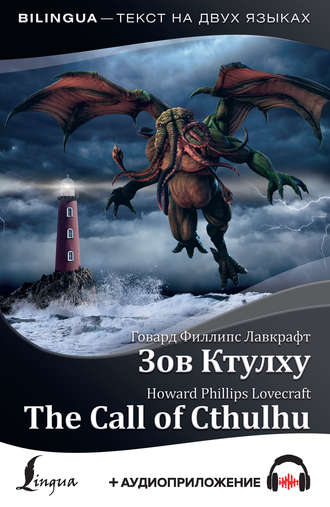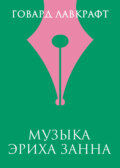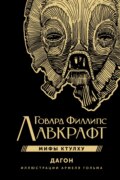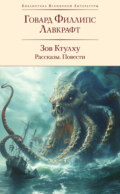
Говард Филлипс Лавкрафт
The Call of Cthulhu / Зов Ктулху (+ аудиоприложение)
Адаптация текста, перевод, упражнения и словарь С.А. Матвеева
© ООО «Издательство АСТ», 2020
Дорогие друзья!
Как известно, лучший способ учить иностранный язык – это читать художественную литературу. Но чтение должно быть не только полезным, но и увлекательным. Поэтому мы отобрали для вас лучшие произведения мировой литературы. В книгах серии Bilingua вы найдёте адаптированные тексты произведений на английском языке с параллельным переводом на русский. В дополнение к текстам даются упражнения на понимание прочитанного с ответами и англо-русский словарь, в котором вы можете уточнить значение конкретного слова.
Все английские тексты озвучены носителями языка и совершенно бесплатно доступны для прослушивания на официальном сайте издательства АСТ. Чтобы воспользоваться бесплатным аудиоприложением, необходимо:
• зарегистрироваться в разделе «Читальня» на официальном сайте издательства АСТ (https://ast.ru/reading-room/),
• перейти в каталог «Аудиоматериалы»,
• выбрать нужный аудиокурс.
После этого вы сможете совершенно бесплатно прослушивать аудиоприложение онлайн или скачать на своё устройство и использовать без подключения к Интернету.
Желаем успехов!
The Call of Cthulhu / Зов Ктулху
I. The Horror in Clay
The most merciful thing in the world, I think, is the inability of the human mind to correlate all its contents. We live on a placid island of ignorance in the midst of black seas of infinity, and it was not meant that we should voyage far. The sciences have harmed us little; but some day the piecing together of dissociated knowledge will open up such terrifying views of reality, that we’ll either go mad from the revelation or flee from the light into the peace and safety of a new dark age.
Theosophists have guessed at the awesome grandeur of the cosmic cycle where our world and human race form transient incidents. Their strange suggestions freeze the blood. Forbidden ages chill me when I think of them and madden me when I dream of them. That glimpse, like all dread glimpses of truth, appeared from an accidental piecing together of separated things: in this case, an old newspaper and the notes of a dead professor. I hope that no one else will make this piecing; certainly, if I live, I shall never add a link in that terrible chain. I think that the professor, too, intended to keep silent, and that he was going to destroy his notes but sudden death stopped him.
My first experience began in the winter of 1926-27 with the death of my great-uncle, George Gammell Angell, Professor Emeritus of Semitic Languages in Brown University, Providence, Rhode Island. Professor Angell was widely known as an authority on ancient inscriptions, and the heads of prominent museums had frequently asked him for help; so his death at the age of ninety-two was talked about. Moreover, interest was intensified by the obscurity of the cause of death. The professor had been stricken while he was returning from the Newport boat. He fell suddenly; as witnesses said, after he had been jostled by a nautical-looking negro who had come from one of the queer dark courts on the precipitous hillside which formed a short way from the waterfront to the professor’s home in Williams Street. Physicians were unable to find any visible disorder, but concluded after perplexed debate that some obscure lesion of the heart, induced by the brisk ascent of a steep hill by so elderly a man, was responsible for the end. At the time I saw no reason to dissent from this dictum, but latterly I began to doubt.
As my great-uncle’s heir and executor, for he died a childless widower, I had to study his papers; and for that purpose I moved his files and boxes to my quarters in Boston. Much of the material will be later published by the American Archaeological Society, but there was one box which I found very puzzling, and which I did not want to show to other eyes. It had been locked and I did not find the key till I examined the personal ring which the professor carried in his pocket. Then, indeed, I opened it, but when I did so I confronted a greater barrier. What was the meaning of the queer clay bas-relief and the disjointed jottings, ramblings, and cuttings which I found? Had my uncle in his latter years become superstitious? I decided to find the eccentric sculptor responsible for this apparent disturbance of an old man’s mind.
The bas-relief was a rough rectangle less than an inch thick and about five by six inches in area; obviously of modern origin. Its designs, however, were far from modern in atmosphere and suggestion. And there was writing of some kind; but my memory could not identify it.
Above hieroglyphics was a figure, an impressionistic picture. It was a sort of monster, or symbol representing a monster, of a form which only a diseased fancy could conceive. If I say that my extravagant imagination offered simultaneous pictures of an octopus, a dragon, and a human caricature, I can present the spirit of it. A pulpy, tentacled head surmounted a grotesque and scaly body with rudimentary wings; and the general outline of the whole monster made it most shockingly frightful. Behind the figure was a vague Cyclopean architectural background.
The writing was made by Professor Angell’s most recent hand; and made no pretense to literary style. The main document was headed “CTHULHU CULT” in characters painstakingly printed to avoid the erroneous reading of an unknown word. This manuscript was divided into two sections, the first of which was headed “1925 – Dream and Dream Work of H.A. Wilcox, 7 Thomas St., Providence, R. I.”, and the second, “Narrative of Inspector John R. Legrasse, 121 Bienville St., New Orleans, La., at 1908 A. A. S. Mtg.—Notes on Same, & Prof. Webb’s Acct.” The other manuscript papers were brief notes, some of them were the queer dreams of different persons, some of them were citations from theosophical books and magazines (notably W. Scott-Elliot’s Atlantis and the Lost Lemuria), and the rest comments on long-surviving secret societies and hidden cults, with references to passages in such mythological and anthropological source-books as Frazer’s Golden Bough and Miss Murray’s Witch-Cult in Western Europe. The articles were mainly about mental illness and outbreaks of group folly or mania in the spring of 1925.
The first half of the principal manuscript told a very interesting tale. On March 1st, 1925, a thin, dark young man of neurotic and excited aspect came to Professor Angell bearing the singular clay bas-relief, which was then exceedingly damp and fresh. His card bore the name of Henry Anthony Wilcox, and my uncle had recognized him as the youngest son of an excellent family slightly known to him, who was studying sculpture at the Rhode Island School of Design and living alone at the Fleur-de-Lys Building near that institution. Wilcox was a precocious young genius with great eccentricity, and had from childhood excited attention through the strange stories and odd dreams. He had the habit of relating them. He called himself “psychically hypersensitive”, but the people of the ancient commercial city treated him as merely “queer.” He had dropped gradually from social visibility, and was now known only to a small group of esthetes from other towns. Even the Providence Art Club, which was trying to preserve its conservatism, had found him quite hopeless.
So, as the professor’s manuscript told, the sculptor abruptly asked to help him identify the hieroglyphics of the bas-relief. He spoke in a dreamy, stilted manner which suggested pose and alienated sympathy; and my uncle showed some sharpness in replying, for the conspicuous freshness of the tablet did not show any relation to archaeology. Young Wilcox’s rejoinder, which impressed my uncle, was of a fantastically poetic nature. He said, “It is new, indeed, for I made it last night in a dream of strange cities; and dreams are older than brooding Tyre, or the contemplative Sphinx, or garden-girdled Babylon.”
Then he began his rambling tale which suddenly won the fevered interest of my uncle. There had been a slight earthquake tremor the night before, the most considerable felt in New England for some years; and Wilcox’s imagination had been greatly affected. He had an unprecedented dream of great Cyclopean cities of Titan blocks and sky-flung monoliths, all dripping with green ooze and sinister with latent horror. Hieroglyphics had covered the walls and pillars, and from some undetermined point below had come a voice that was not a voice; a chaotic sensation which only fancy could transmute into sound, but which he attempted to render by the almost unpronounceable combination of letters: “Cthulhu fhtagn.”
This verbal jumble was the key to the recollection which excited and disturbed Professor Angell. He questioned the sculptor with scientific interest; and studied the bas-relief on which the young man had been working, chilled and clad only in his night clothes. My uncle blamed his old age, Wilcox afterwards said, because he could not recognize both hieroglyphics and pictorial design fast enough. Many of his questions seemed highly inappropriate to his visitor, especially those which tried to connect the things with strange cults or societies; and Wilcox could not understand the promises of silence which he was offered in exchange for an admission of membership in some widespread mystical or paganly religious society. When Professor Angell became convinced that the sculptor was indeed ignorant of any cult or system of cryptic lore, he asked his visitor to supply him with future reports of dreams. This bore regular fruit, because after the first interview the manuscript records daily visits of the young man, during which he related startling fragments of nocturnal imagery. He was always talking about some terrible Cyclopean views of dark and dripping stone, with a subterrene voice or intelligence shouting monotonously enigmatical uninscribable gibberish. The two sounds frequently repeated are rendered by the letters “Cthulhu” and “R’lyeh.”
On March 23, the manuscript continued, Wilcox did not come; he had been stricken with an obscure fever and taken to the home of his family in Waterman Street. He had cried out in the night, arousing several other artists in the building, and had showed since then only alternations of unconsciousness and delirium. My uncle at once telephoned the family, and from that time watched the case; calling often at the Thayer Street office of Dr. Tobey. The young man’s febrile mind, apparently, was dwelling on strange things; and the doctor was shuddering as he spoke of them. They included not only a repetition of what he had formerly dreamed, but concerned gigantic things “miles high” which walked or lumbered about. He never fully described these objects but occasional frantic words, as repeated by Dr. Tobey, convinced the professor that they were identical with the nameless monsters he had depicted in his dream-sculpture. Reference to this object, the doctor added, was invariably a prelude to the young man’s lethargy. His temperature, oddly enough, was quite normal; but the whole condition was like true fever rather than mental disorder.
On April 2 at about 3 p.m. every trace of Wilcox’s illness suddenly ceased. He sat upright in bed, astonished to find himself at home and completely ignorant of what had happened in dream or reality since the night of March 22. His physician declared recovering, and he returned to his quarters in three days; but he was not able to help Professor Angell. All traces of strange dreaming had vanished with his recovery, and my uncle kept no record of his night-thoughts after a week of pointless and irrelevant usual visions.
Here the first part of the manuscript ended, but it gave me much material for thought. The notes were the descriptions of the dreams of various persons covering the same period as that in which young Wilcox had had his strange visits. My uncle, it seems, was inquiring amongst nearly all the friends whom he could question, asking for nightly reports of their dreams, and the dates of any notable visions for some time past. He received so many responses, that it was impossible to handle them without a secretary. This original correspondence was not preserved, but his notes formed a thorough and really significant digest. Average people in society and business gave an almost completely negative result, though there were some formless nocturnal impressions, between March 23 and April 2 – the period of young Wilcox’s delirium. Four cases gave vague descriptions of strange landscapes, and in one case there was mentioned a dread of something abnormal.
The answers of artists and poets were the most interesting, and I suspect that panic would have appeared if they had compared the notes. But these were not original letters, and I suspected that they were being asked leading questions, or that the correspondence was edited. That is why I continued to feel that Wilcox had been imposing on the veteran scientist. The responses from esthetes told disturbing tale. From February 28 to April 2 a large proportion of them had dreamed very bizarre things, the intensity of the dreams was immeasurably stronger during the period of the sculptor’s delirium. Over a fourth of them reported scenes and half-sounds – like those which Wilcox had described; and some of the dreamers were afraid of the gigantic nameless thing which became visible at the end. One case was very sad. A widely known architect with great interest toward theosophy and occultism went violently insane on the date of young Wilcox’s seizure, and several months later was still continuously screaming. He was asking for help, he wanted to be saved from some escaped denizen of hell. If my uncle had mentioned the real names instead of numbers, I would have done some personal investigation; but as it was, I succeeded in tracing down only a few. And it is well that no explanation ever reached them.
The newspapers’ articles, as I have learned, were concerned with cases of panic, mania, and eccentricity during the given period. Professor Angell’s collection was tremendous, and the sources were scattered throughout the globe. Here was a nocturnal suicide in London, where a man had leaped from a window after a shocking cry. Here was a letter to the editor of a newspaper in South America, where a fanatic pretold future from visions he had seen. An article from California described a theosophist colony: people in white robes were preparing for some “glorious fulfillment” which never arrived. Articles from India spoke of serious native unrest toward the end of March 22—23. The west of Ireland, too, was full of wild rumour and legendary stories, and a fantastic painter named Ardois-Bonnot offered a blasphemous “Dream Landscape” in the Paris spring salon of 1926. The recorded troubles in insane asylums were very numerous as well. But I was then convinced that young Wilcox had known of the older matters mentioned by the professor and had set all of this aside.
I. Ужас, воплощённый в глине
Теософы предположили удивительное великолепие космического цикла, в котором наш мир и человеческая раса составляют лишь временные обители. Их странные предположения леденят кровь. Запретные эпохи вызывают во мне дрожь, когда я думаю о них, и раздражают меня, когда я вижу их во сне. Этот проблеск, как и все ужасные проблески истины, возник от случайного соединения воедино разрозненных фрагментов: в данном случае это были старая газета и записки умершего профессора. Я надеюсь, что никто больше не свершит такого соединения; конечно, если я буду жить, то никогда не добавлю ни одного звена к той ужасной цепи. Я думаю, что профессор также намеревался хранить молчание и собирался уничтожить свои записки, но внезапная смерть остановила его.
Мой первый опыт случился зимой 1926-27 годов со смертью моего двоюродного деда, Джорджа Гэммела Энджелла, заслуженного профессора в отставке, специалиста по семитским языкам в Брауновском университете в Провиденсе, Род-Айленд. Профессор Энджелл был широко известен как специалист по древним письменам, и руководители известных музеев часто обращались к нему за помощью; поэтому его смерть в возрасте девяноста двух лет обсуждалась. Кроме того, интерес усиливался туманной причиной смерти. Смерть настигла профессора, когда он возвращался с ньюпортского парохода. Он внезапно упал, как сообщили свидетели, после того как его толкнул негр, по виду – моряк, который появился из одного подозрительного тёмного двора на крутом склоне, по которому пролегал короткий путь от береговой линии к дому профессора на Уильямс-стрит. Врачи не смогли обнаружить что-либо, выходящее за пределы нормы, но после путаных обсуждений заключили, что смерть наступила вследствие неясного повреждения сердца, вызванного напряжённым подъёмом столь пожилым человеком по крутому холму. В то время я не видел причин возражать такому выводу, но впоследствии я начал сомневаться.
Будучи наследником и душеприказчиком своего двоюродного деда – поскольку он умер бездетным вдовцом, – я должен был изучить его бумаги; и с этой целью я перевёз его папки и ящики к себе в Бостон. Бóльшая часть материала будет позже опубликована Американским археологическим обществом, но был там один ящик, который показался мне весьма загадочным и который я не хотел показывать другим. Он был заперт, и я не мог найти ключа, пока не осмотрел личную связку, которую профессор носил в кармане. Тогда, наконец, я открыл ящик, но, сделав это, я наткнулся на ещё большее препятствие. Что означали странный глиняный барельеф и найденные мною разрозненные записки и вырезки? Неужели мой дядя стал в последние годы суеверным? Я решил найти чудаковатого скульптора, ответственного за это очевидное помутнение ума старика.
Барельеф представлял собой неправильный четырёхугольник толщиной менее дюйма и площадью приблизительно пять на шесть дюймов; он явно имел современное происхождение. Однако его вид по духу и по замыслу был далёк от современности. И там присутствовали также письмена; но моя память не могла их идентифицировать.
Над иероглифами была фигура, некая импрессионистская картина. Это было своего рода чудовище, или символ, представляющий чудовище: такое могло породить только больное воображение. Если я скажу, что моё экстравагантное воображение предложило мне одновременно образы осьминога, дракона и карикатуры на человека, то я смогу передать дух этой картины. Мясистая, снабженная щупальцами голова венчала гротескное чешуйчатое тело с недоразвитыми крыльями; и общий контур этого чудовища делал его столь отвратительно пугающим. Позади фигуры виднелись фоновые циклопические строения.
Записки были сделаны рукой профессора Энджелла совсем недавно и не претендовали на какой-либо литературный стиль. Основной документ был озаглавлен тщательно выписанными буквами «КУЛЬТ КТУЛХУ», чтобы избежать ошибочного прочтения неизвестного слова. Эта рукопись была поделена на две части, первая из которых была озаглавлена «1925 – Сны и сновидческое творчество Г. Э. Уилкокса, Томас-стрит 7, Провиденс, Р. А.», а вторая – «Рассказ инспектора Джона Р. Леграсса, Бьенвиль-стрит 121, Новый Орлеан, на собрании А. А. О. – заметки о том же + сообщение профессора Уэбба». Остальные бумаги были краткими записями, некоторые из них представляли странные сны различных людей, некоторые содержали цитаты из теософических книг и журналов (особенно из книги У. Скотт-Эллиота «Атлантида и исчезнувшая Лемурия»), а прочие были комментариями о действующих и поныне тайных обществах и скрытых культах, со ссылками на цитаты из таких мифологических и антропологических источников, как книги Фрэзера «Золотая ветвь» и мисс Мюррей «Культ ведьм в Западной Европе». Статьи были, главным образом, об умственных расстройствах и вспышках группового помешательства или мании весной 1925-го года.
Первая половина основной рукописи содержала очень интересный рассказ. 1-го марта 1925-го года к профессору Энджеллу явился худой темноволосый взволнованный молодой человек. Он принёс с собой глиняный барельеф, который был тогда ещё свежим и влажным. На карточке значилось его имя – Генри Энтони Уилкокс, и мой дядя признал в нём младшего сына одного благородного семейства, немного ему известного. Юноша изучал скульптуру в Художественной школе Род-Айленда и жил один в особняке Флёр-де-Лис, около места своей учёбы. Уилкокс был не по годам развитым, весьма эксцентричным молодым гением и с раннего детства выказывал живой интерес к странным историям и непонятным сновидениям. У него была привычка их рассказывать. Он называл себя «психически сверхчувствительным», но жители старого коммерческого городка считали его просто «чудаком». Он постепенно стал пропадать из поля зрения общества и был теперь известен только небольшой группе эстетов из других городов. Даже Клуб любителей искусства в Провиденсе, который пытался сохранить свой консерватизм, считал его почти безнадёжным.
Итак, как сообщала рукопись профессора, скульптор сразу попросил помочь ему идентифицировать иероглифы на барельефе. Он говорил в мечтательной, высокопарной манере, которая предполагала позёрство и не вызывала симпатии; и мой дядя ответил ему достаточно резко, потому что подозрительная свежесть артефакта показывала, что он не имеет никакого отношения к археологии. Возражение молодого Уилкокса, произведшее на моего дядю впечатление, носило фантастически поэтический характер. Он сказал: «Действительно, он совсем новый, поскольку я изготовил его вчера ночью во сне, когда мне снились странные города; а сны древнее мечтательного Тира, созерцательного Сфинкса или окружённого садами Вавилона».
Потом он начал свой хаотичный рассказ, который внезапно вызвал жгучий интерес моего дяди. Прошлой ночью случилось небольшое землетрясение, наиболее ощутимое в Новой Англии за последние годы; и это сильно затронуло воображение Уилкокса. У него был невероятный сон об огромных циклопических городах из каменных плит и взметнувшихся в небо монолитах, они источали зелёную илистую жидкость и были начинены скрытым ужасом. Иероглифы покрывали стены и столбы, и откуда-то снизу доносился голос, который голосом не был; но который он попытался передать почти непроизносимым сочетанием букв: «Ктулху фхтагн».
Эта словесная путаница была ключом к воспоминанию, которое взволновало и расстроило профессора Энджелла. Он с научным интересом расспросил скульптора и исследовал барельеф, над которым поработал молодой человек, продрогший и одетый лишь в ночную сорочку. Уилкокс впоследствии сказал, что мой дядя винил свою старость, потому что он не смог достаточно быстро распознать иероглифы и изображение. Многие его вопросы казались посетителю совершенно посторонними, особенно те, которые пытались связать всё это со странными культами или обществами; и Уилкокс не мог понять заверения профессора в молчании, которое тот предложил ему в обмен на признание своего членства в каком-нибудь распространённом мистическом или языческом религиозном обществе. Когда профессор Энджелл убедился, что скульптор действительно не осведомлён о каком-либо культе или системе криптографии, он попросил, чтобы его посетитель в будущем докладывал бы ему о своих снах. Это принесло плоды, потому что после первого интервью в рукописи имеется запись о ежедневных визитах молодого человека, во время которых он рассказывал о ярких моментах своего ночного воображения. Он всегда рассказывал об ужасных циклопических пейзажах из тёмных и сочащихся камней, о подземном голосе или разуме, монотонно выкрикивающем загадочную неописуемую тарабарщину. Два часто повторяемых слова передаются буквосочетаниями «Ктулху» и «Р’льех».
23-го марта, продолжала рукопись, Уилкокс не пришёл; его поразила неизвестная лихорадка, и его увезли в семейный дом на Уотермен-стрит. Ночью он кричал, разбудив других художников в здании, и с тех пор выказывал только чередование беспамятства и бреда. Мой дядя сразу позвонил семье и с того времени следил за происходящим, частенько справляясь в приёмной доктора Тоби на Тейер-стрит. Лихорадочный ум юноши, очевидно, населяли странные вещи; и доктор дрожал, когда говорил о них. Там содержалось не только то, что юноша прежде видел во сне, но также упоминались гигантские твари «высотой в милю», которые бродили или неуклюже двигались вокруг. Он никогда полностью не описывал эти объекты, но случайные безумные слова, повторенные доктором Тоби, убедили профессора, что они идентичны безымянным монстрам, которых юноша изобразил в своей сновидческой скульптуре. Упоминание этого объекта, добавил доктор, было у молодого человека неизменной прелюдией к летаргии. Достаточно странно, что его температура была нормальна; но состояние в целом походило скорее на настоящую лихорадку, а не на психическое расстройство.







